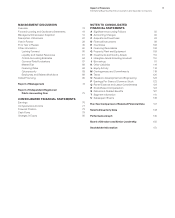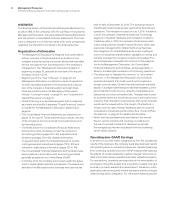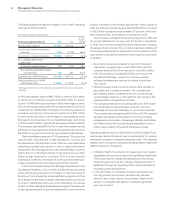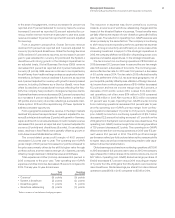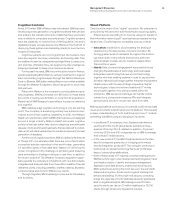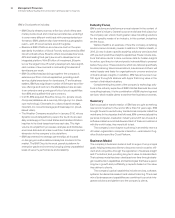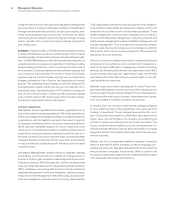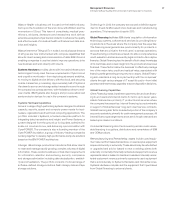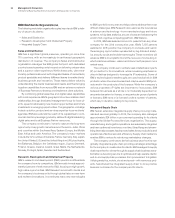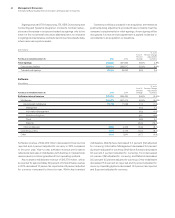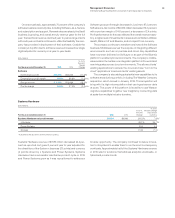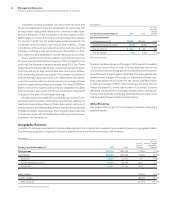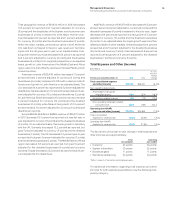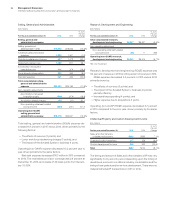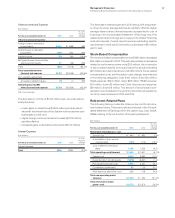IBM 2015 Annual Report Download - page 29
Download and view the complete annual report
Please find page 29 of the 2015 IBM annual report below. You can navigate through the pages in the report by either clicking on the pages listed below, or by using the keyword search tool below to find specific information within the annual report.27
Management Discussion
International Business Machines Corporation and Subsidiary Companies
Watson Health: a business unit focused on the health industry,
built upon the foundation of the work done with Watson and the
momentum of Cloud. This team of consultants, medical prac-
titioners, clinicians, developers and researchers work with an
extensive ecosystem of partners and clients to advance the quality
and effectiveness of individual health with advanced data ana-
lytics and insights.
Watson Internet of Things (IoT): in today’s world, physical devices
of all types are now instrumented with compute capabilities that
allow for direct sensing and communication of data. IBM’s focus is
enabling companies to use that data to improve operations, drive
new business and work directly with clients.
Systems Hardware provides clients with innovative infrastructure
technologies to help meet the new requirements of hybrid cloud
and cognitive workloads—from deploying advanced analytics,
to moving to digital service delivery with the cloud, and securing
mobile transaction processing. Approximately half of Systems
Hardware’s server and storage sales transactions are through
the company’s business partners; with the balance direct to end-
user clients. IBM Systems also designs and procures advanced
semiconductor devices for use in the company’s systems.
Systems Hardware Capabilities
Servers: a range of high-performing systems designed to address
capacity, security, speed and compute power needs for busi-
nesses, organizations and technical computing applications. The
portfolio includes zSystems, a trusted enterprise platform for
integrating data, transactions and insight, and Power Systems, a
system designed from the ground up for big data, optimized for
scale-out cloud and Linux, and delivering open innovation with
OpenPOWER. The company is also a founding member of the
OpenPOWER foundation, a group of industry-leading companies
working together to develop high-performance compute solutions
based on the IBM POWER architecture.
Storage: data storage products and solutions that allow clients
to retain and manage rapidly growing, complex volumes of digital
information. These solutions address critical client requirements
for information retention and archiving, security, compliance
and storage optimization including data deduplication, availabil-
ity and virtualization. The portfolio consists of a broad range of
software-defined storage solutions, flash storage, disk and tape
storage solutions.
Tec h nolog y: In 2014, the company announced a definitive agree-
ment to divest its Microelectronics business and manufacturing
operations. This transaction closed in 2015.
Global Financing facilitates IBM clients’ acquisition of information
technology systems, software and services by providing financ-
ing solutions in the areas where the company has the expertise.
The financing arrangements are predominantly for products or
services that are critical to the end users’ business operations.
These financing contracts are entered into after a comprehensive
credit evaluation and are secured by legal contracts. As a captive
financier, Global Financing has the benefit of both deep knowledge
of its client base and a clear insight into the products and services
financed. These factors allow the business to effectively manage
two of the major risks, credit and residual value, associated with
financing while generating strong returns on equity. Global Financ-
ing also maintains a long-term partnership with the companies’
clients through various stages of IT asset life cycle—from initial
purchase and technology upgrades to asset disposition decisions.
Global Financing Capabilities
Client Financing: lease, installment payment plan and loan financ-
ing to end users and internal clients for terms up to seven years.
Assets financed are primarily IT products and services where
the company has expertise. Internal financing is predominantly
in support of Global Services’ long-term client service contracts.
Global Financing also factors a selected portion of the company’s
accounts receivable, primarily for cash management purposes. All
internal financing arrangements are at arm’s-length rates and are
based upon market conditions.
Commercial Financing: short-term inventory and accounts receiv-
able financing to suppliers, distributors and remarketers of IBM
and OEM products.
Remanufacturing and Remarketing: assets include used equip-
ment returned from lease transactions, or used surplus equipment
acquired internally or externally. These assets may be refurbished
or upgraded and sold or leased to new or existing clients both
externally or internally. Externally remarketed equipment revenue
represents sales or leases to clients and resellers. Internally remar-
keted equipment revenue primarily represents used equipment
that is sold internally to Systems Hardware and Global Services.
Systems Hardware may also sell the equipment that it purchases
from Global Financing to external clients.


